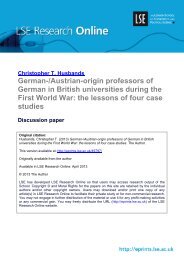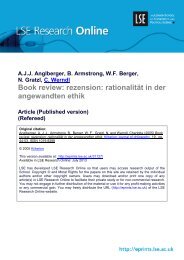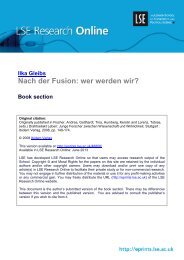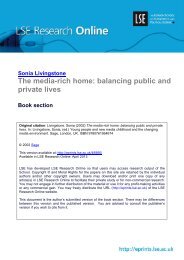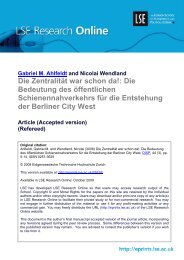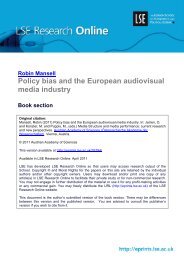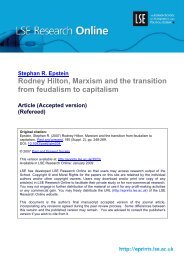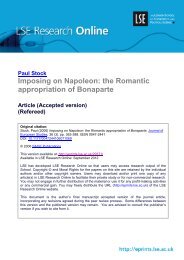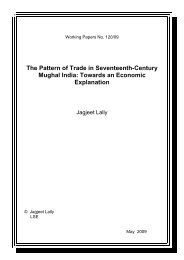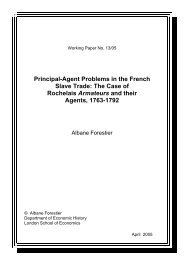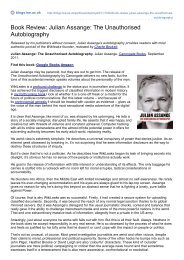Download (535Kb) - LSE Research Online - London School of ...
Download (535Kb) - LSE Research Online - London School of ...
Download (535Kb) - LSE Research Online - London School of ...
Create successful ePaper yourself
Turn your PDF publications into a flip-book with our unique Google optimized e-Paper software.
and Fox andTaqqu's (1986) extension to long memory <strong>of</strong> the central limit theorem (CLT) for Whittle<br />
estimates <strong>of</strong> Hannan (1973) under short memory, the existence and basic structure <strong>of</strong> Edgeworth<br />
expansions for Whittle estimates <strong>of</strong> parametric long memory models can be anticipated. Indeed,<br />
Liebermann, Rousseau and Zucker (2001) have developed valid Edgeworth expansions (<strong>of</strong> arbitrary<br />
order) for quadratic forms <strong>of</strong> Gaussian long memory series, with application to sample autocovariances<br />
and sample autocorrelations. Edgeworth expansions have also been developed for some<br />
statistics, which, like e and b, converge at slower, `nonparametric', rates. We note for example the<br />
work <strong>of</strong> Bentkus and Rudzkis (1982) on smoothed nonparametric spectral density estimates for short<br />
memory Gaussian time series, later developed by Velasco and Robinson (2001), while related results<br />
have also been obtained for smoothed nonparametric probability density estimates by Hall (1991)<br />
and for Nadaraya-Watson nonparametric regression estimates by Robinson (1995c). However, this<br />
literature seems small compared to the parametric one, and the development and study <strong>of</strong> Edgeworth<br />
expansions for semiparametric estimates <strong>of</strong> the memory parameter seems an especially distinctive<br />
problem, especially in view <strong>of</strong> the current interest in such estimates due to their exibility discussed<br />
above, the notational and expositional advantage <strong>of</strong> being able to focus on a single parameter 0, the<br />
simple parameter-estimate-free studentization a orded by (1.4)and (1.7), and the interesting role<br />
played by the bandwidth m in a semiparametric set-up, in which terms due to the bias can compete<br />
with Edgeworth terms <strong>of</strong> a more standard character indeed, our Edgeworth expansion provides a<br />
method <strong>of</strong> choosing m, proposed by Nishiyama and Robinson (2000) in another context, which seems<br />
more appropriate in the context <strong>of</strong> statistical inference than the usual minimum-mean-squared-error<br />
rules.<br />
We study here only b, and trimmed and tapered versions <strong>of</strong> it, not so much because <strong>of</strong> its<br />
greater rst-order e ciency than e, as its greater mathematical tractability. Though, unlike e, it<br />
is not de ned in closed form, its higher-order properties can nevertheless be analysed by making<br />
use <strong>of</strong> general results for implicitly-de ned extremum estimates <strong>of</strong> Bhattacharya and Ghosh (1978),<br />
whereas the logged periodograms appearing in e are technically di cult to handle. Our theory<br />
also requires development <strong>of</strong> Edgeworth expansions for quadratic forms <strong>of</strong> a type not covered by<br />
Lieberman, Rousseau and Zucker (2001) (due principally to the narrow-band nature <strong>of</strong> ours, in the<br />
frequency domain). Various other estimates <strong>of</strong> 0 that are also semiparametric in character have<br />
been studied, such as versions <strong>of</strong> the R/S statistic, the averaged periodogram estimate, and the<br />
variance type estimate. However, not only do these also converge more slowly than n 1 2 under the<br />
semiparametric speci cation, but unlike e and b they are not necessarily asymptotically normal, or<br />
they may be asymptotically normal only over a subset <strong>of</strong> values, where they can have a complicated<br />
-dependent asymptotic variance they have a nonstandard limit distribution elsewhere. Such<br />
estimates are thus much less convenient for use in statistical inference than e and b, and moreover<br />
do not lend themselves so readily to higher-order analysis. Though higher-order approximations to<br />
the distribution <strong>of</strong> b are <strong>of</strong> course more complicated than (1.7), they are, as we show, still usable,<br />
and indeed can be approximated by a normal distribution with a corrected mean and variance, so<br />
that normal-based inference is still possible.<br />
We give greater stress to a (cosine bell) tapered version <strong>of</strong> b, where the m frequencies employed<br />
are not the adjacent Fourier ones, at 2 =n intervals, as used in (1.6), but are separated by 6 =n intervals,<br />
so that two j are "skipped". The skipping avoids the correlation across nearby frequencies<br />
that is induced by tapering, which otherwise improves the iid approximation <strong>of</strong> the periodogram ratios<br />
rj, toenableavalid Edgeworth expansion with a correction term <strong>of</strong> order m ;1=2 (with desirably<br />
a completely known coe cient), along with a higher order "bias" term, which is increasing in m. The<br />
m ;1=2 correction term is what we would expect from the classical Edgeworth literature, obtaining<br />
in case <strong>of</strong> weighted periodogram spectral density estimates for short memory series. Without the<br />
tapering and skipping, the m ;1=2 term appears to be dominated by something which we estimate<br />
as <strong>of</strong> order m ;1=2 log 4 m, but if m increases su ciently fast this term is in any case dominated by



